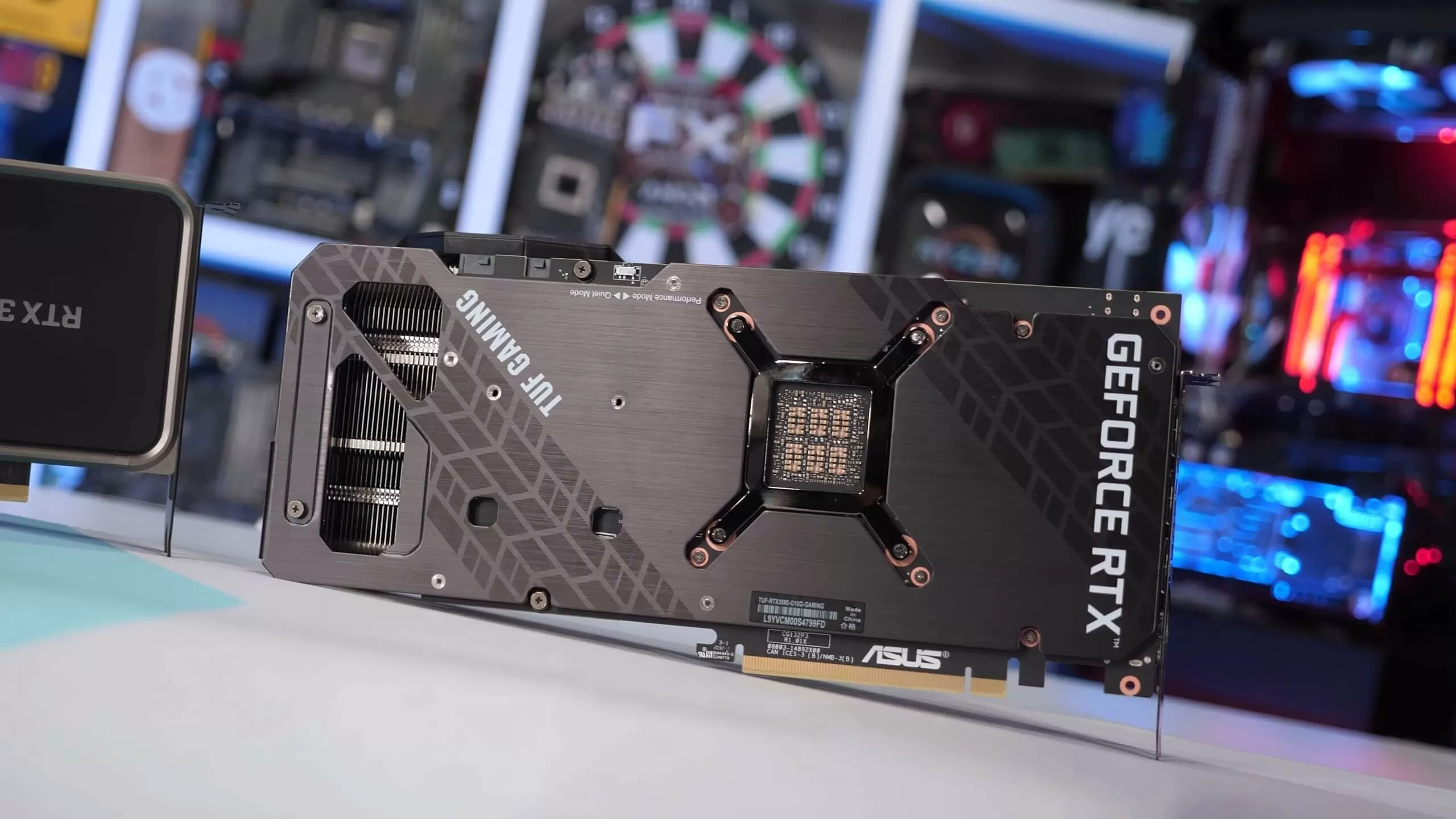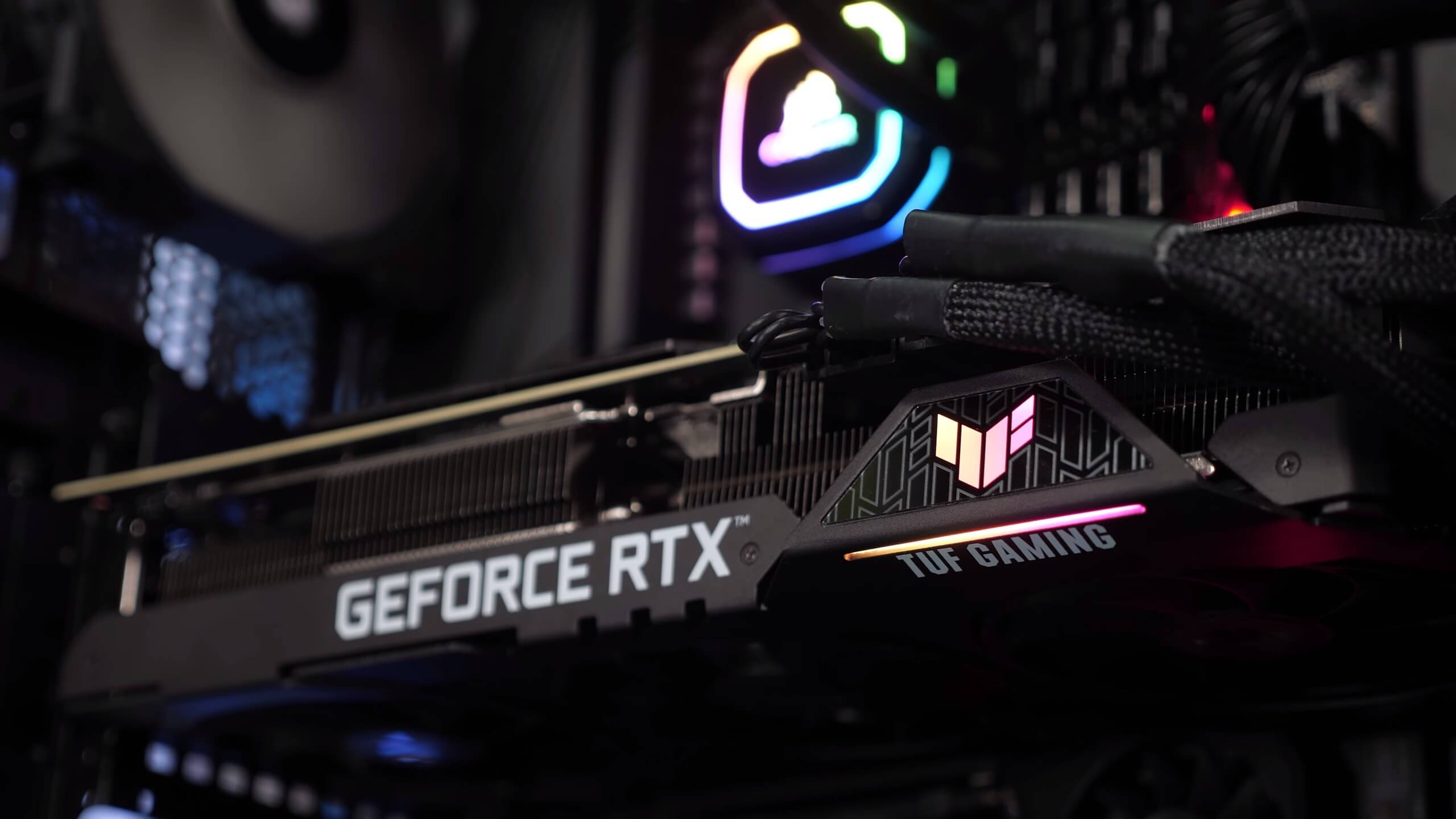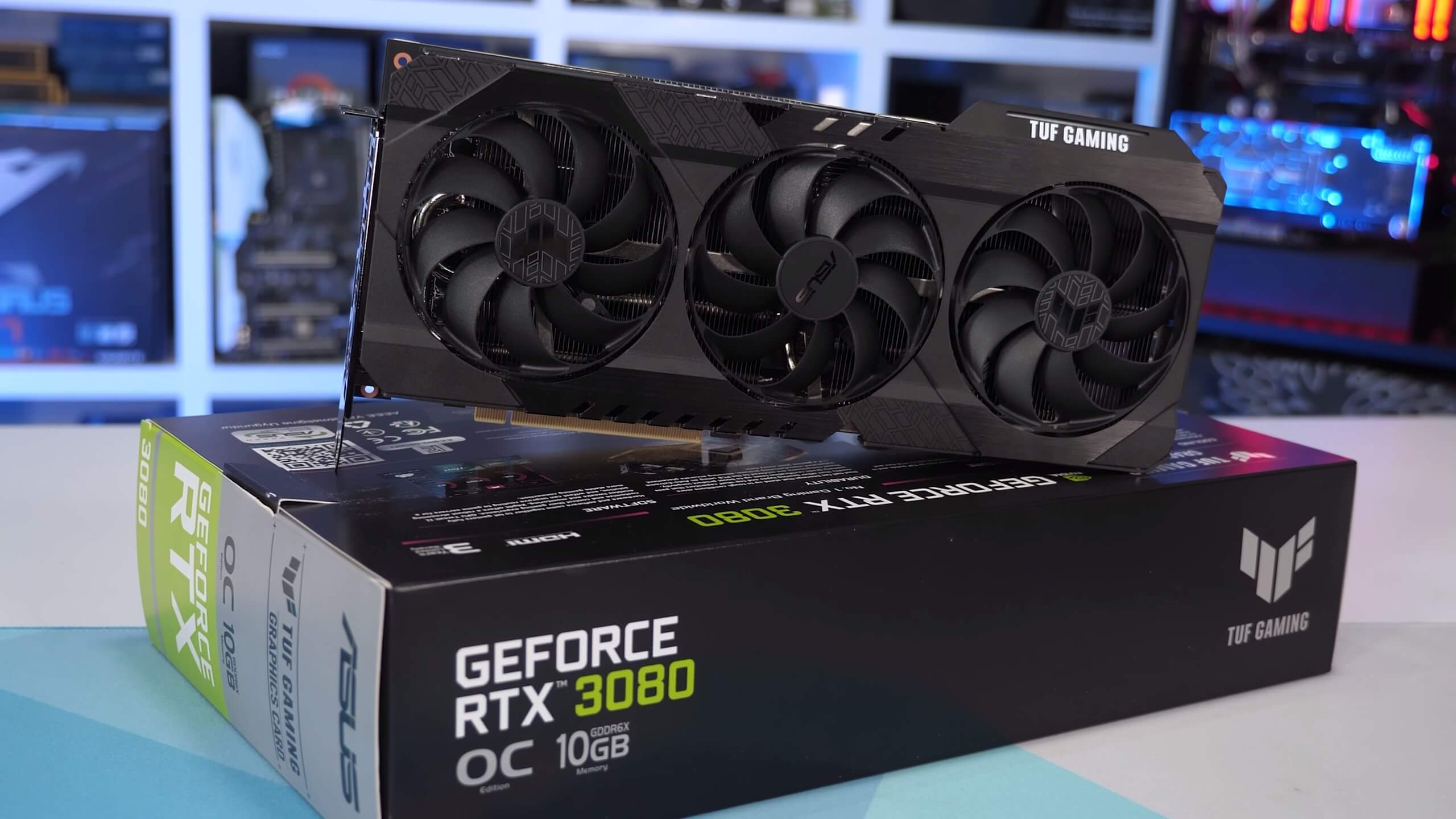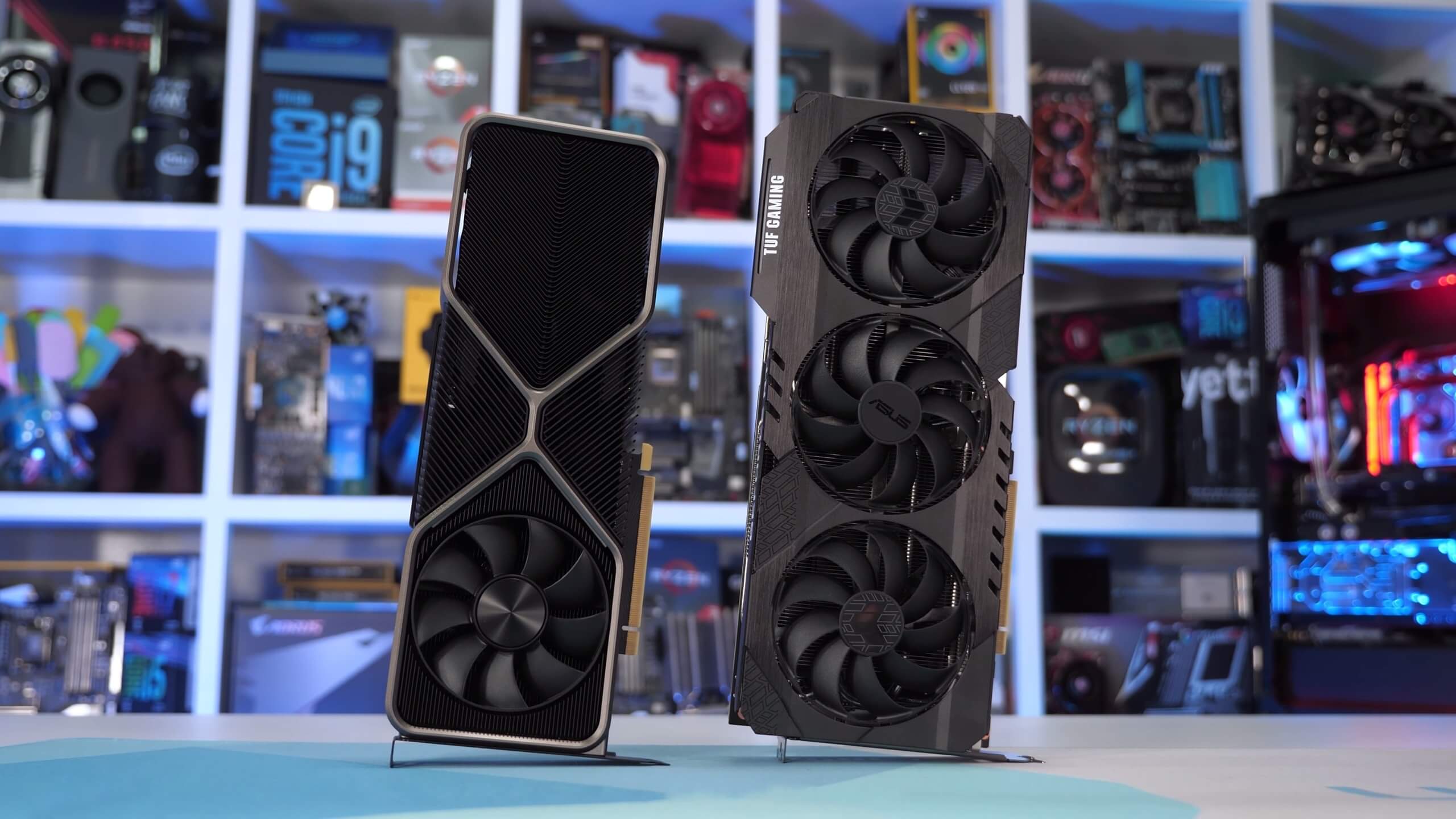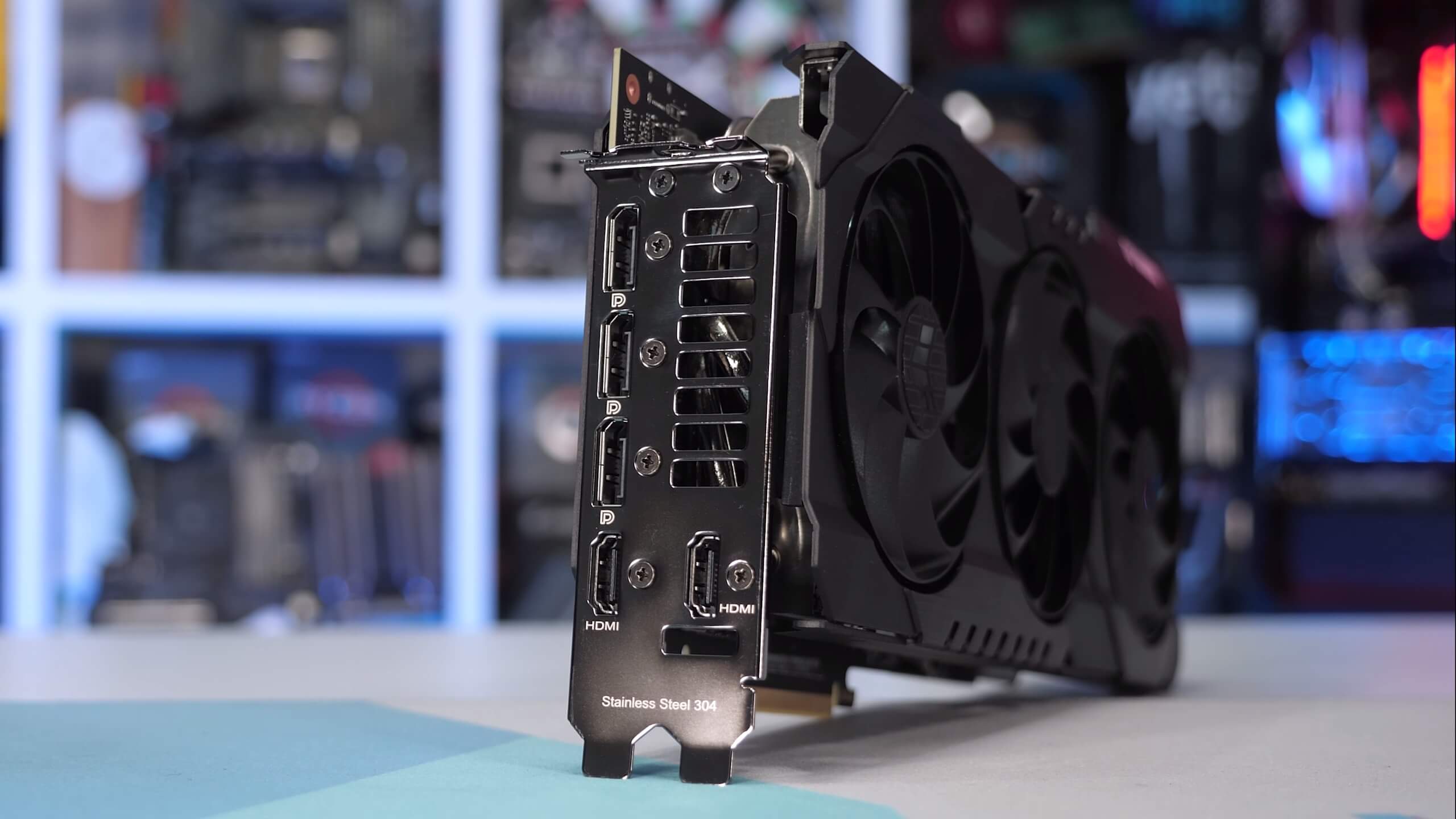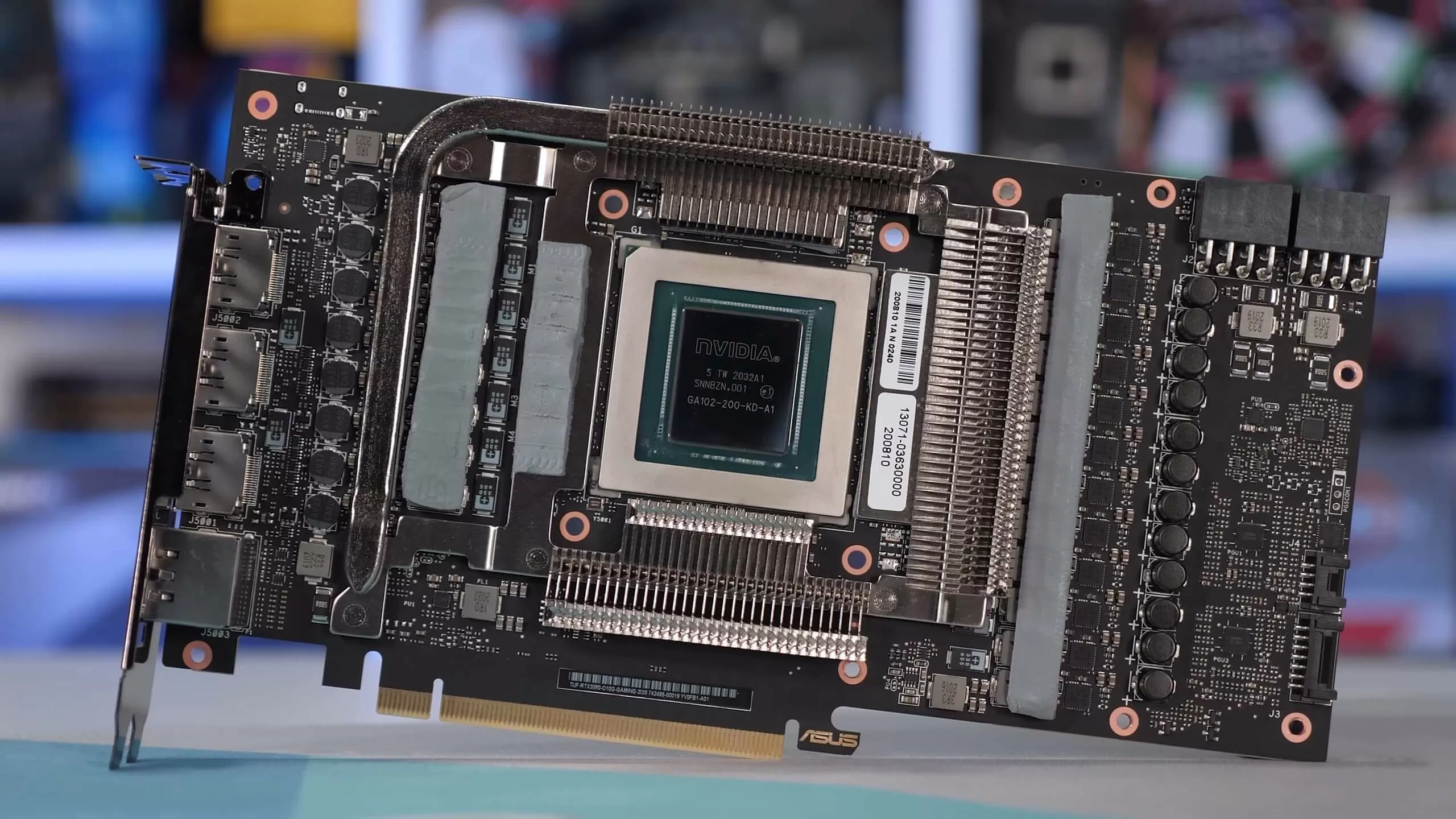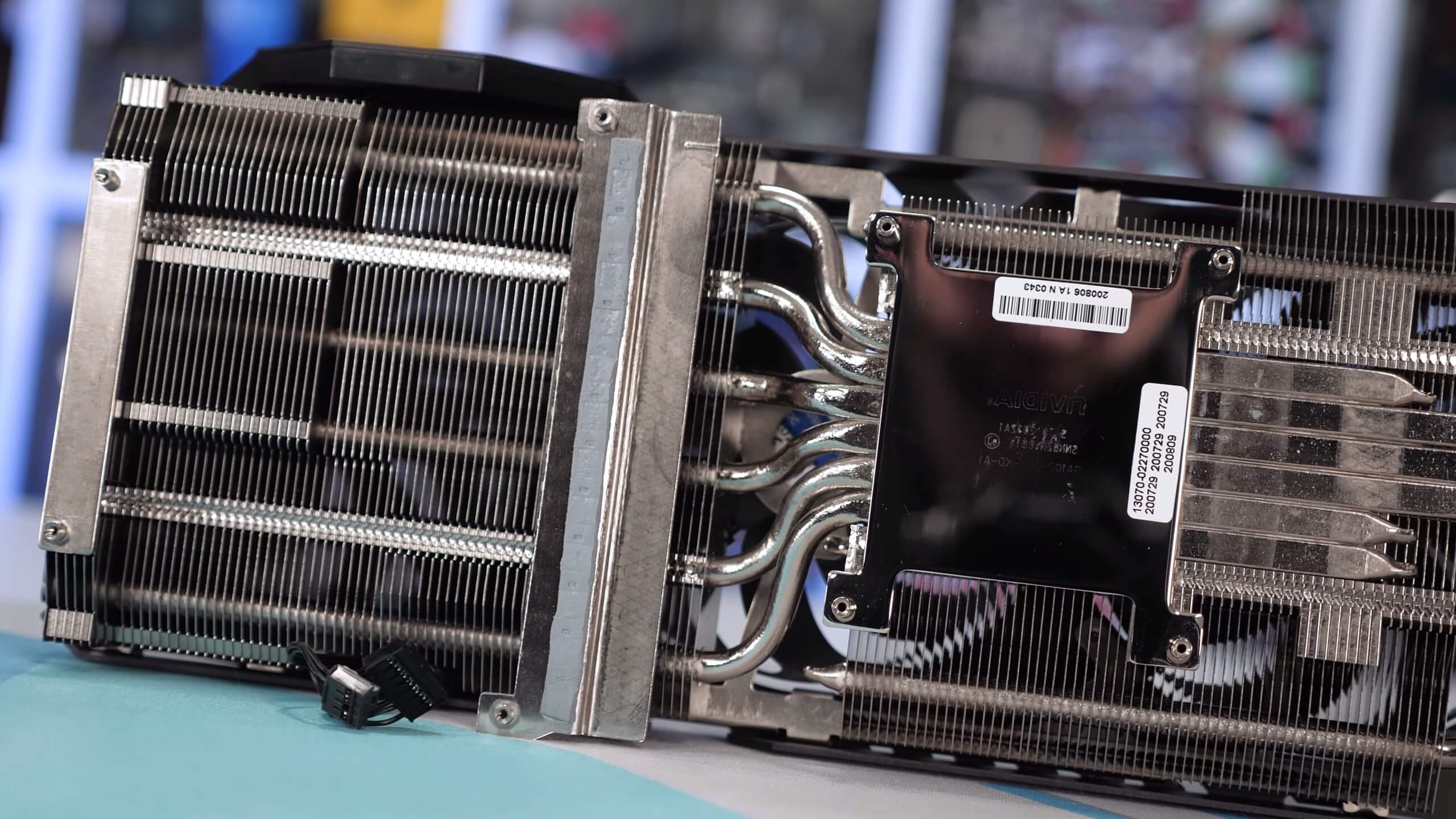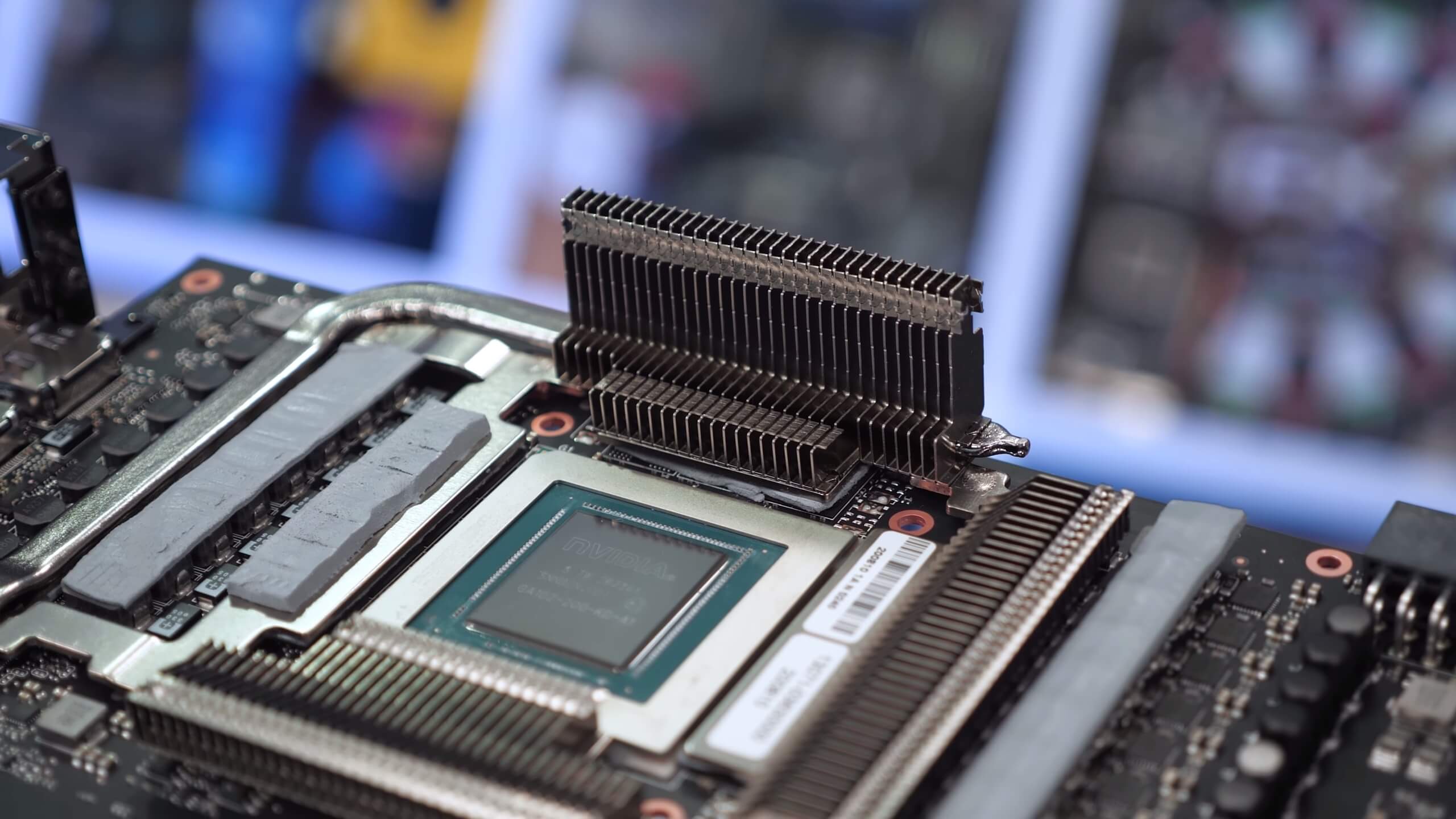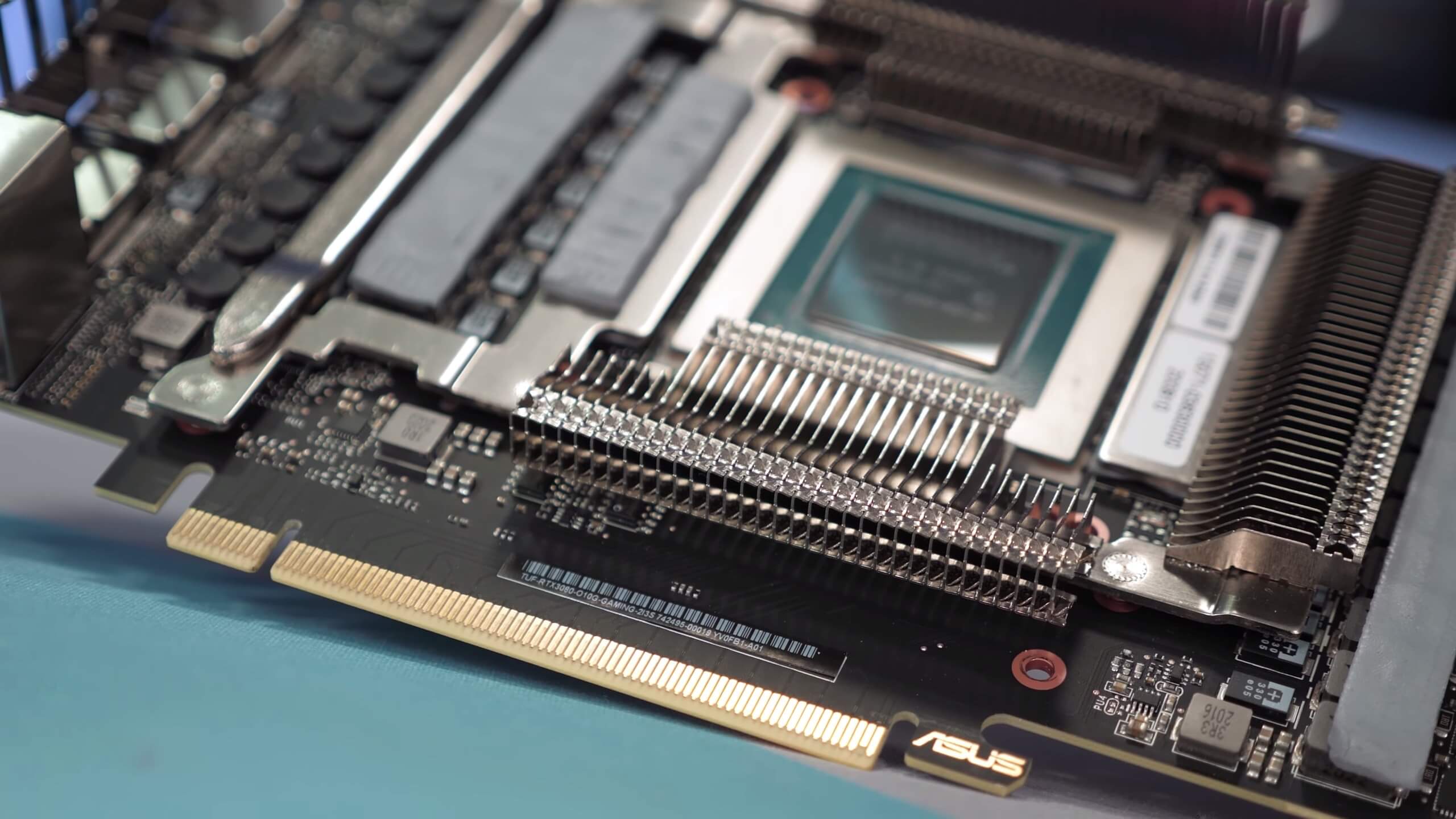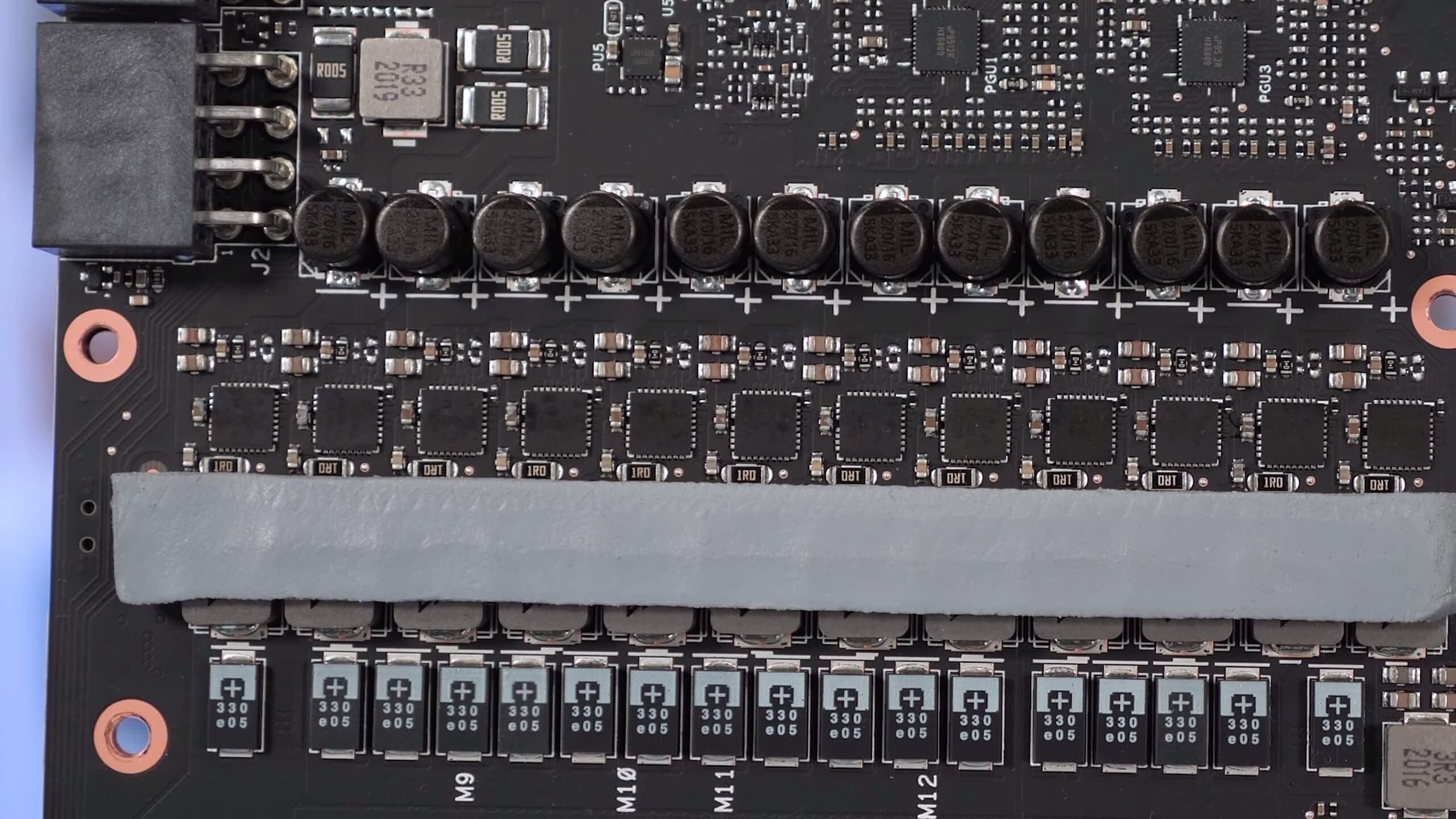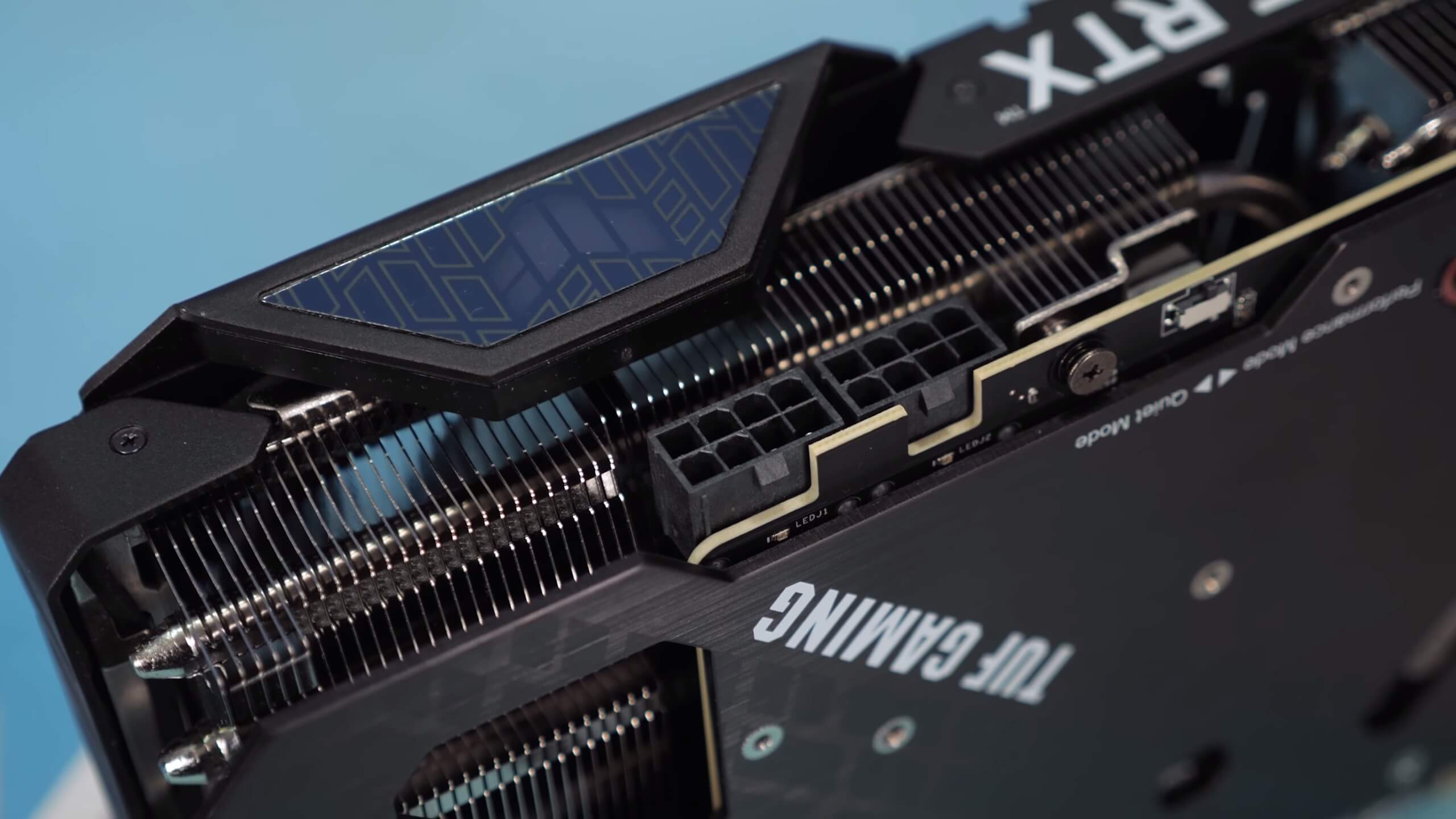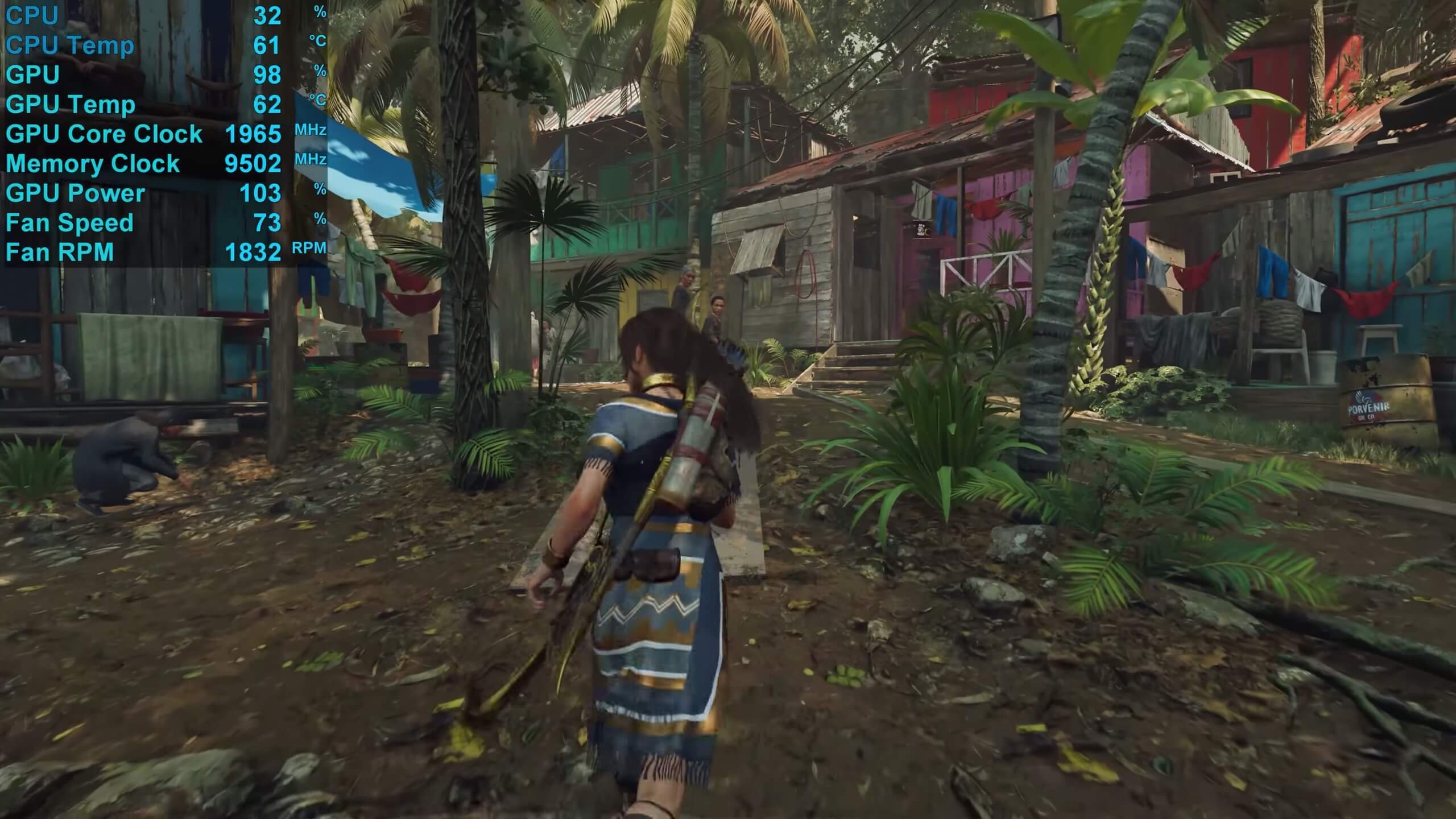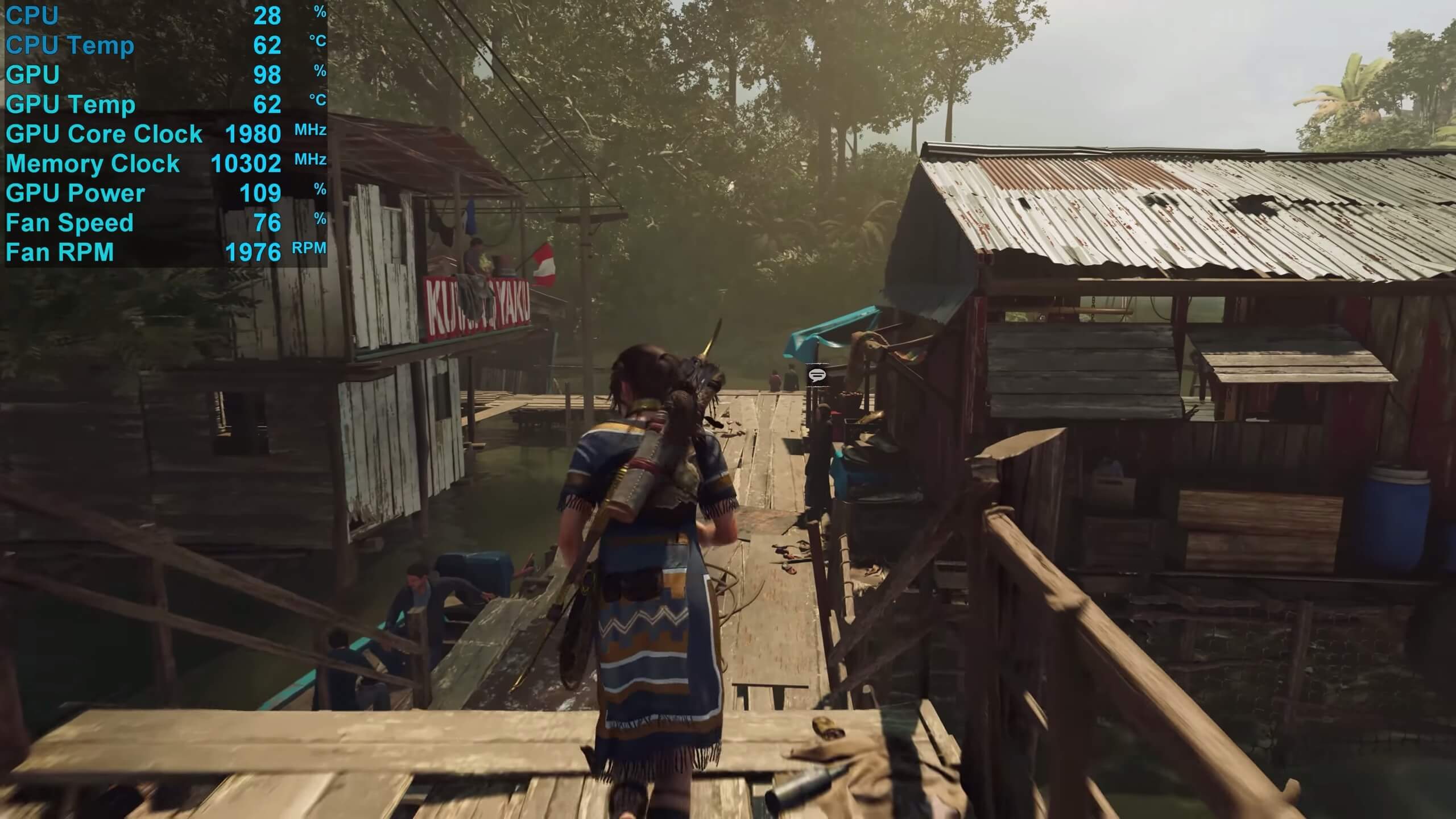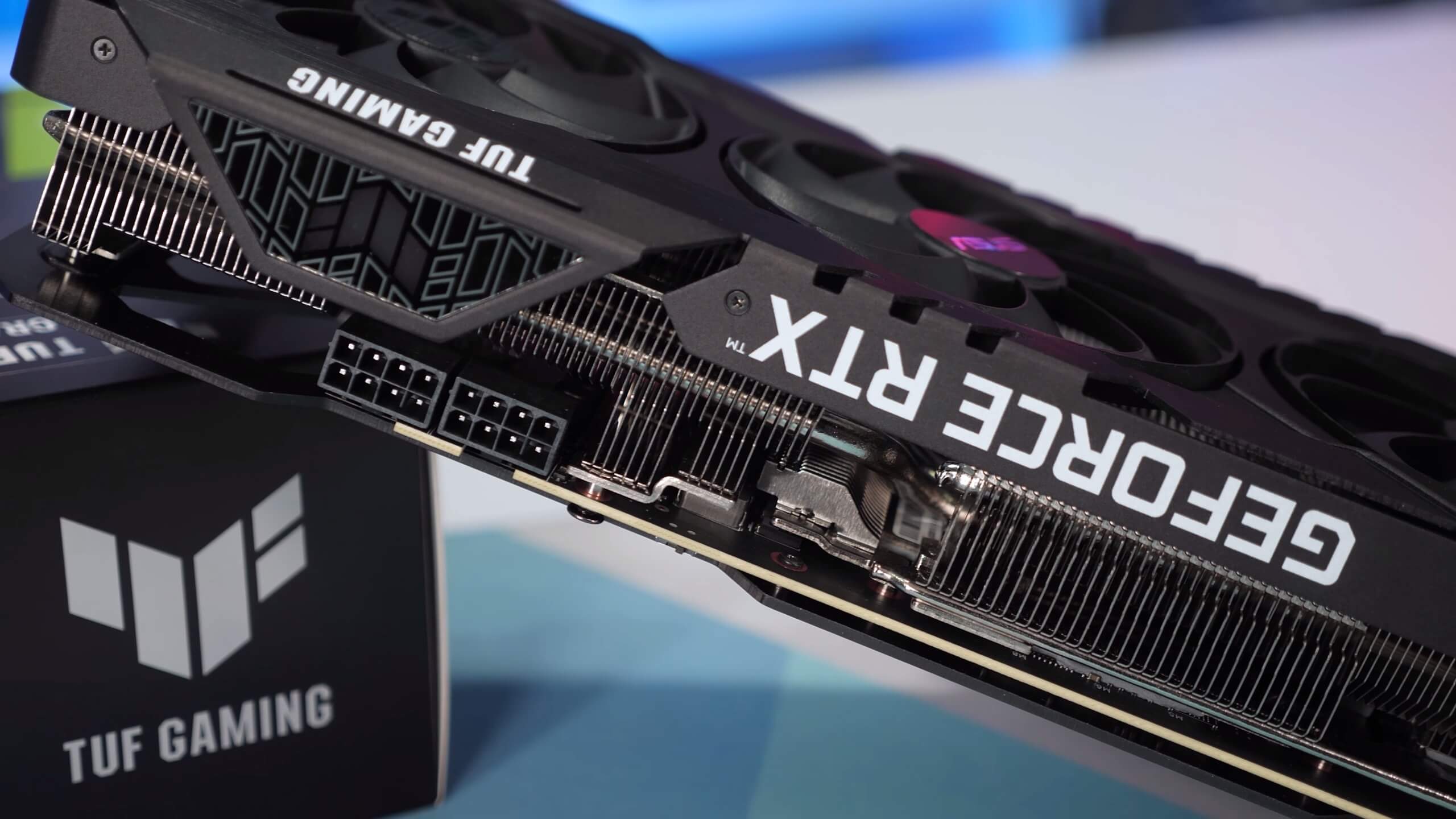Today we're reviewing the Asus TUF Gaming RTX 3080 OC, the first third-party GeForce RTX 3080 graphics card to come our way and we're very interested to see how it compares to Nvidia's Founders Edition model. We'll be checking out gaming performance which should be very similar to the FE card, but also thermal and overclocking results.
First, let's tear the TUF Gaming RTX 3080 OC down and take a look at the cooler and PCB. Please note this was done after we collected all our thermal and performance data. Starting with LED lighting, because of course, that's important. The TUF is minimalist which we like, there is a small light bar above the 'TUF' branding along with a backlit logo which faces outwards when the card is traditionally mounted.
In terms of design and appearance, the TUF Gaming looks like your typical high-end graphics card. It's a 2.7-slot design, so it takes up 3 slots, it measures 30cm long, stands 12.7cm tall and weighs in at 1385 grams, so it's slightly heavier than the 1355 gram Founders Edition model. It's mostly black, so it will suit most builds and Asus has included a few 'TUF' theme design elements like the tire tracks on the backplate, for example.
We liked how there's no plastic on the card, apart from the fans of course. The fan shroud has been constructed from aluminum, giving it a premium look. Asus are also using the axial-tech fans and since there are three in total, they've reversed the rotation of the center fan to reduce turbulence, the fans each measure 90mm in diameter. We should also note that the card includes a stop-fan feature which activates when the GPU drops below 55C.
Around at the I/O end of the card we find two HDMI 2.1 ports and three DisplayPort 1.4a outputs. That's an extra HDMI output when compared to Nvidia's FE version, though note it can still only support up to 4 simultaneous displays. Asus also points out that this model features a very robust stainless steel I/O bracket which they say protects against rust while providing a more durable and secure mount. Can't say we've ever had an issue with the standard steel brackets, but if you have, well this will be a welcomed feature.
Pulling this thing apart to take a better look, starting with the heatsink and fans, we have a very serious looking heatsink here, in fact it looks like something you'd expect to find on an ROG Strix model and not a card with TUF branding, and it really is very large, weighing in at 820 grams.
There are two massive banks of fins which are connected using half a dozen 6mm thick nickel plated copper heatpipes, and all connect to a large nickel plated copper base plate.
Using an aluminum plate, it directly cools the VRM, so that's good to see, but there's a lot more to this design as there is a second heatsink which directly cools the GDDR6X memory as well as the power delivery for the memory components. It's an impressive bit of kit that fits in snug beneath the main heatsink. Asus have also used a few high quality thermal pads to aid in heat transfer from this smaller heatsink to the primary heatsink. Oh and for those of you wondering the smaller heatsink weighs in at 70 grams.
On the back side of the card we find a rather thick aluminum back plate which weighs 138 grams and has been used to strengthen the card and reduce PCB sag, or in this case completely eliminate it. We think this is actually the thickest backplate we've ever seen on a graphics card. Asus has also employed a series of thermal pads to remove built up heat from the rear side of the PCB behind the VRM and GDDR6X memory chips. There's also a few cut outs to aid in air-flow.
Now over to the PCB, we find a 24cm long by 10.6cm tall PCB, so a fairly compact board, though it is crammed full of components. Surrounding the massive GA102 die are the GDDR6X memory chips and then flanking them on either side are boatloads of inductors and power stages. In total the card packs 20 power stages, and here we're looking at an 8 + 6 + 4 power phase design using SIC641ACD 55A powerstages, though please note two of the 8-phases drive two power stages, so a bit of an odd configuration, but this is what Asus has gone with.
If you're wondering what the 8 and 6-phase portions power, the answer is the GPU. So 14 phases feed into the GPU, or 16 55A powerstages. The 8-phase power rail is for NVVDD and the 6-phase power rail is for MSVDD while the 4-phase power rail is for the GDDR6X memory.
For comparison, the Nvidia reference board uses an 8 + 5 + 3 power phase design featuring 50A Alpha & Omega Semiconductor power stages. In other words, Asus has beefed up the TUF Gaming well over the Nvidia reference spec.
There's also two 8-pin PCIe power connectors feeding power into the graphics card and you'll also find a dual BIOS switch that allows you to change from the default 'performance' BIOS to a 'quiet' BIOS. Both modes run the card at 340 watts, so we're just looking at a change to the fan profile which will see the card run hotter in the quiet mode.
In terms of clock specifications, Asus lists a core clock frequency of 1815 MHz which is a 5% boost over the 1730 MHz default spec. The GDDR6X memory though has been left at 19 Gbps, so we're just looking at a typical mild GPU overclock here. All that said, let's move on to see what clock speed this model maintains when underload.
For these GeForce 30 series graphics card reviews we'll be using Shadow of the Tomb Raider for all stress testing and will be reporting temperatures after 30 minutes of gameplay. This saw the TUF Gaming peak at just 63 degrees in a 21 degree room inside the Corsair Obsidian 500D, fully populated with fans. That's a massive 15 degree drop in temperature when compared to Nvidia's Founders Edition model.
To maintain this temperature the fans spin at up to 1900 RPM and while that's a reasonably high fan speed, the card was surprisingly quiet, generating just 42 dBA of noise, making it slightly quieter than the FE version. The typical core clock speed seen during our testing was 1935 MHz and under the same conditions that's a 5% increase over the Founders Edition model. This saw power consumption increase by 7% from 323 watts with the FE model to 344 watts with the TUF Gaming.
Overclocking
Now for overclocking, with the limits reached we again saw a peak operating temperature of 63 degrees but this time the fans spun up to 2000 RPM. The card wasn't terribly loud at this fan speed. The overclock saw the cores operate at 2 GHz and the memory also hit 20.6 Gbps, an impressive transfer speed. Finally, when overclocked the card sucked down 357 watts, a small 4% increase from the factory OC configuration.
Let's move into the benchmark graphs to see what overclocking gets us. We're testing with our Ryzen 9 3950X GPU test rig with 32GB of DDR4-3200 CL14 memory. The latest drivers available at the time of testing have been used, and for this one we have just a few select games to look at.
Benchmarks
Starting with Death Stranding numbers at 1440p, the TUF Gaming was a single frame faster than Nvidia's FE model, hitting 158 fps. That's a pretty disappointing increase and we weren't able to do much better with a manual overclock, boosting performance by a further 2%.
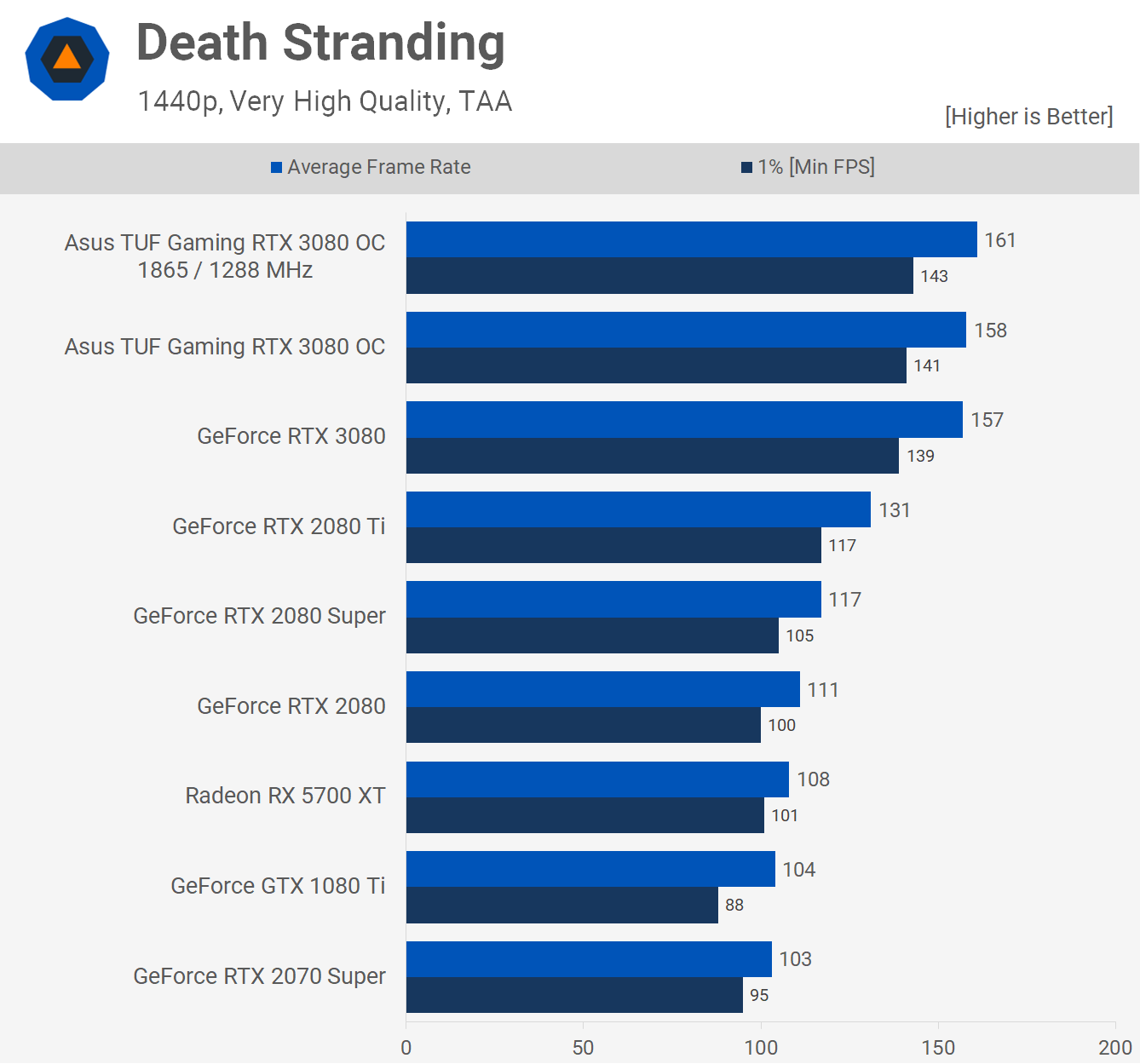
The results at 4K were just as underwhelming, here the TUF Gaming was 2% faster than the FE model and our overclock netted us an extra 2% performance.
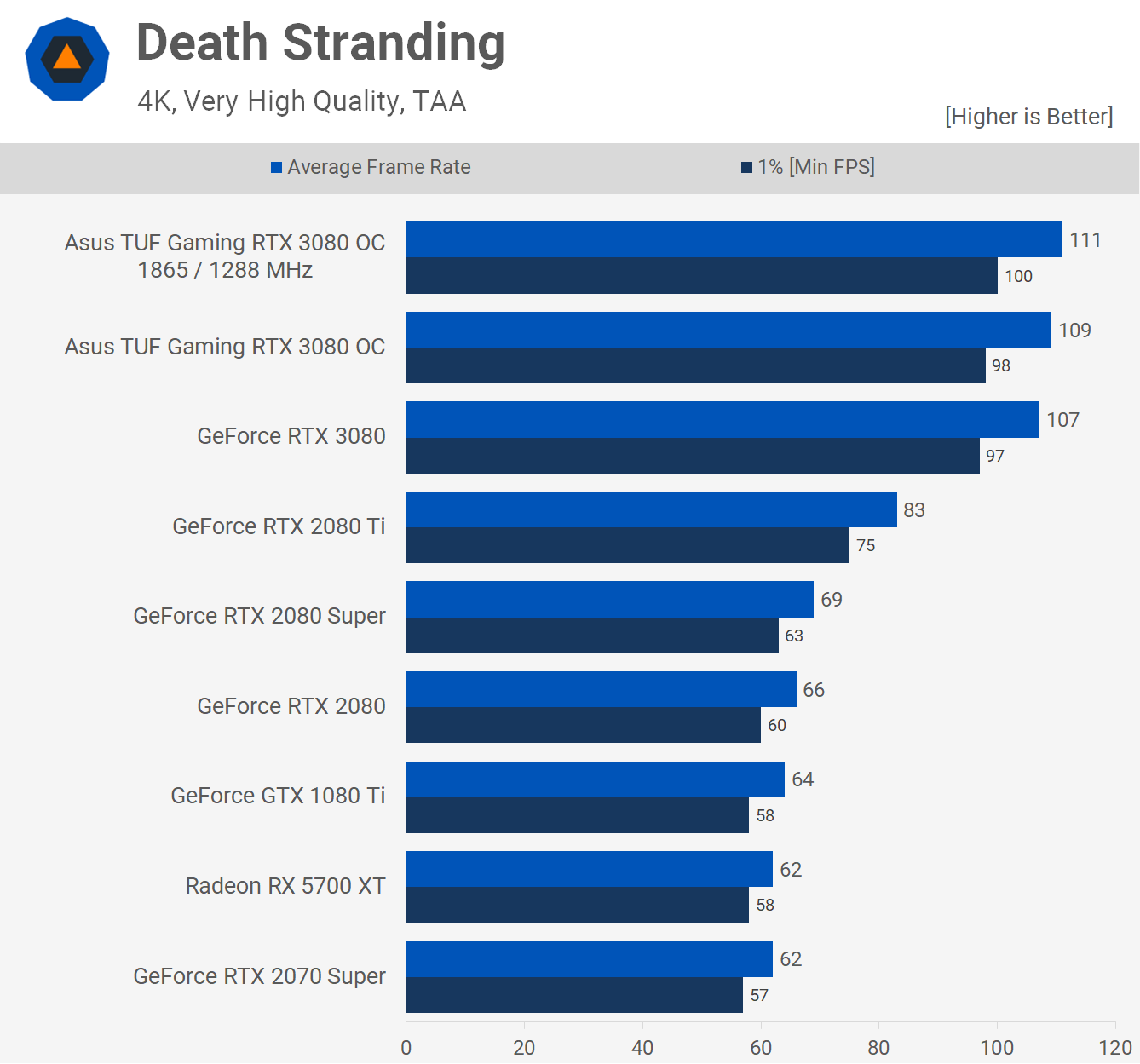
The gains seen in Rainbow Six Siege were a little more impressive, here the TUF Gaming was 6% faster than Nvidia's FE model, hitting 346 fps. That's a typical factory overclock, but unfortunately through further manual tuning we were only able to extract 2 extra frames, well under a single percent gained here.
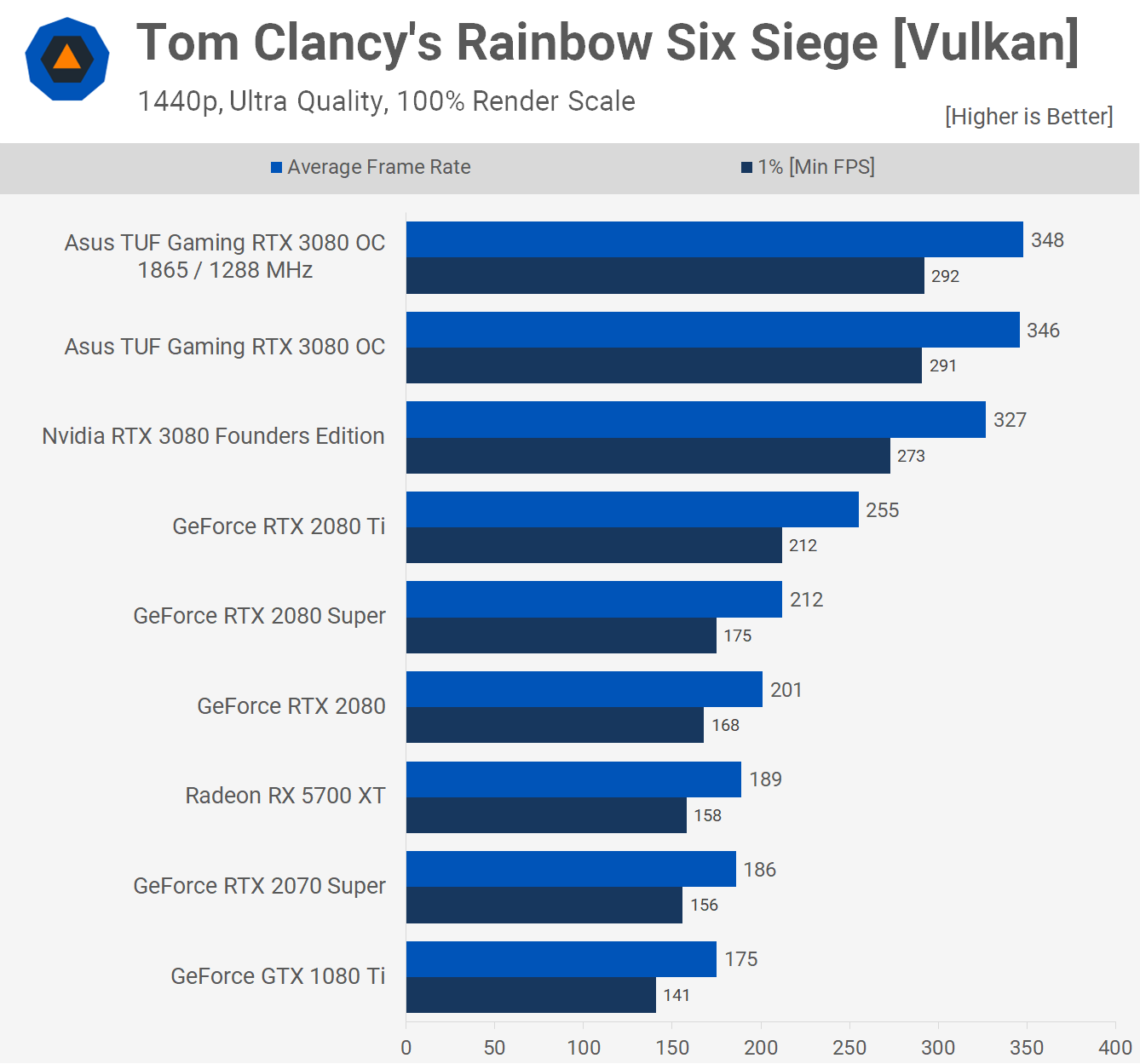
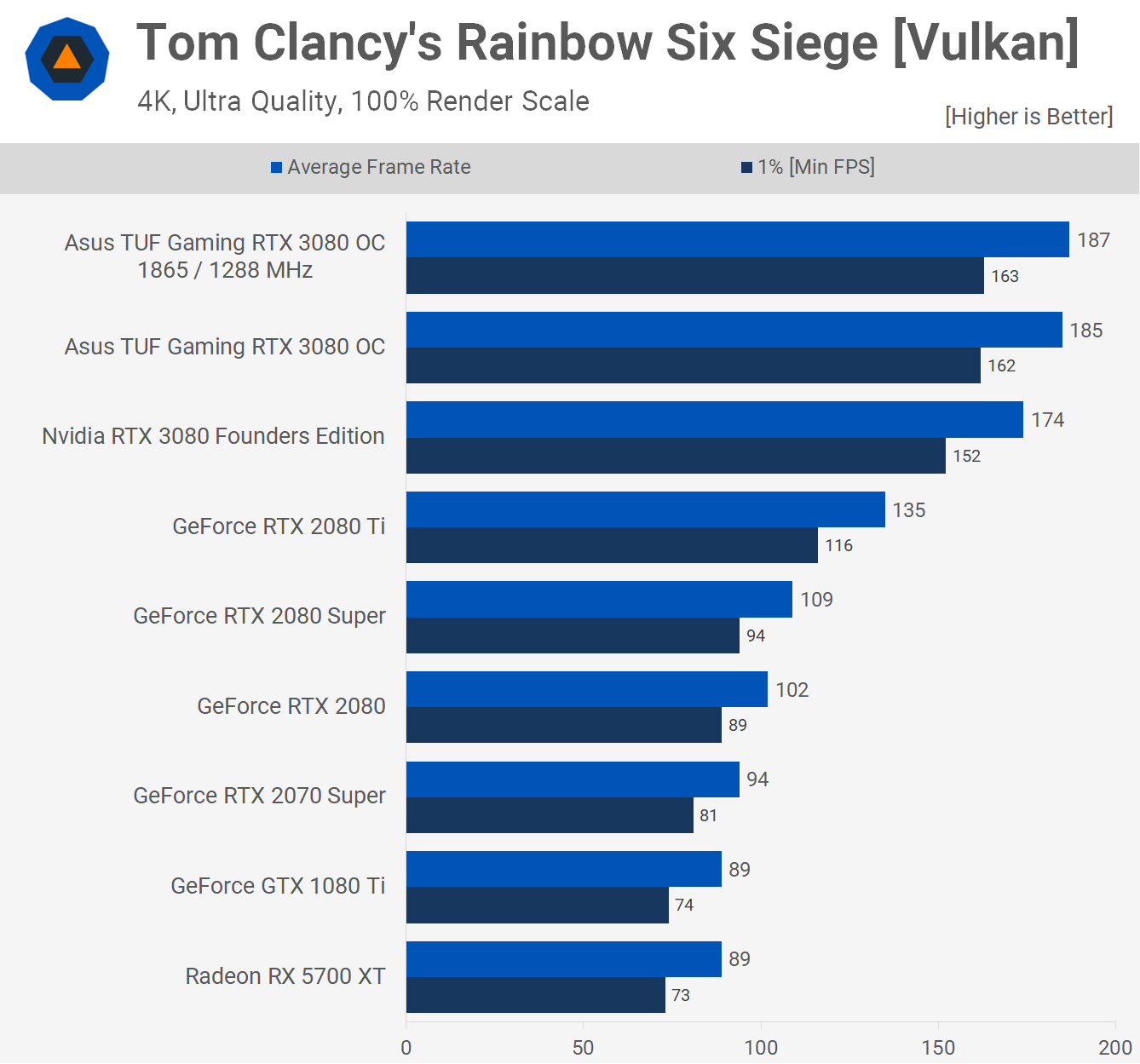
The 4K data looks much the same, again the TUF Gaming was 6% faster than Nvidia's Founders Edition model and our manual overclock was useless.
Shadow of the Tomb Raider saw a 4% increase for the TUF Gaming over the FE model at 1440p, though quite interestingly this time our manual overclock netted us a further 3% increase in performance.
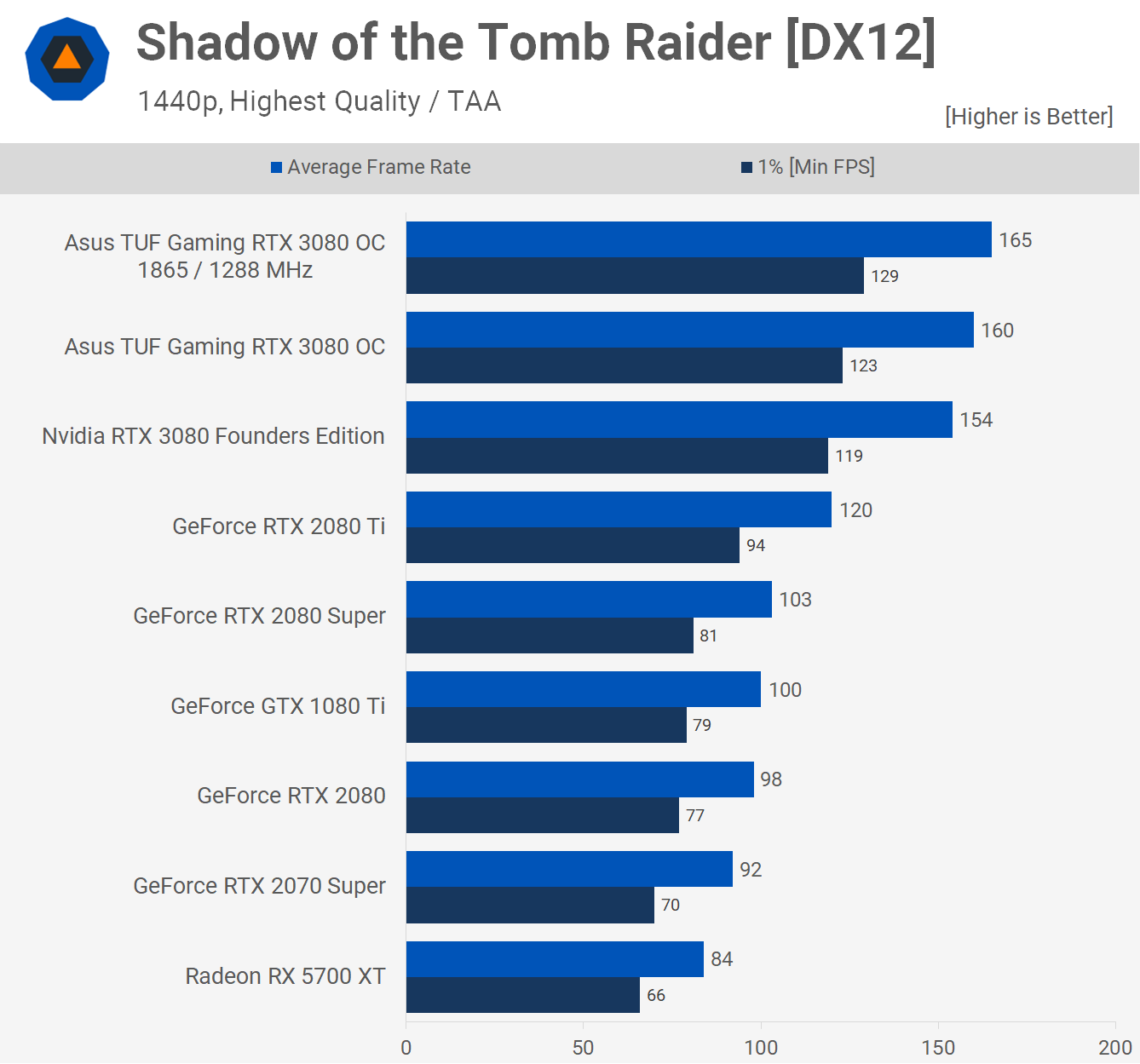
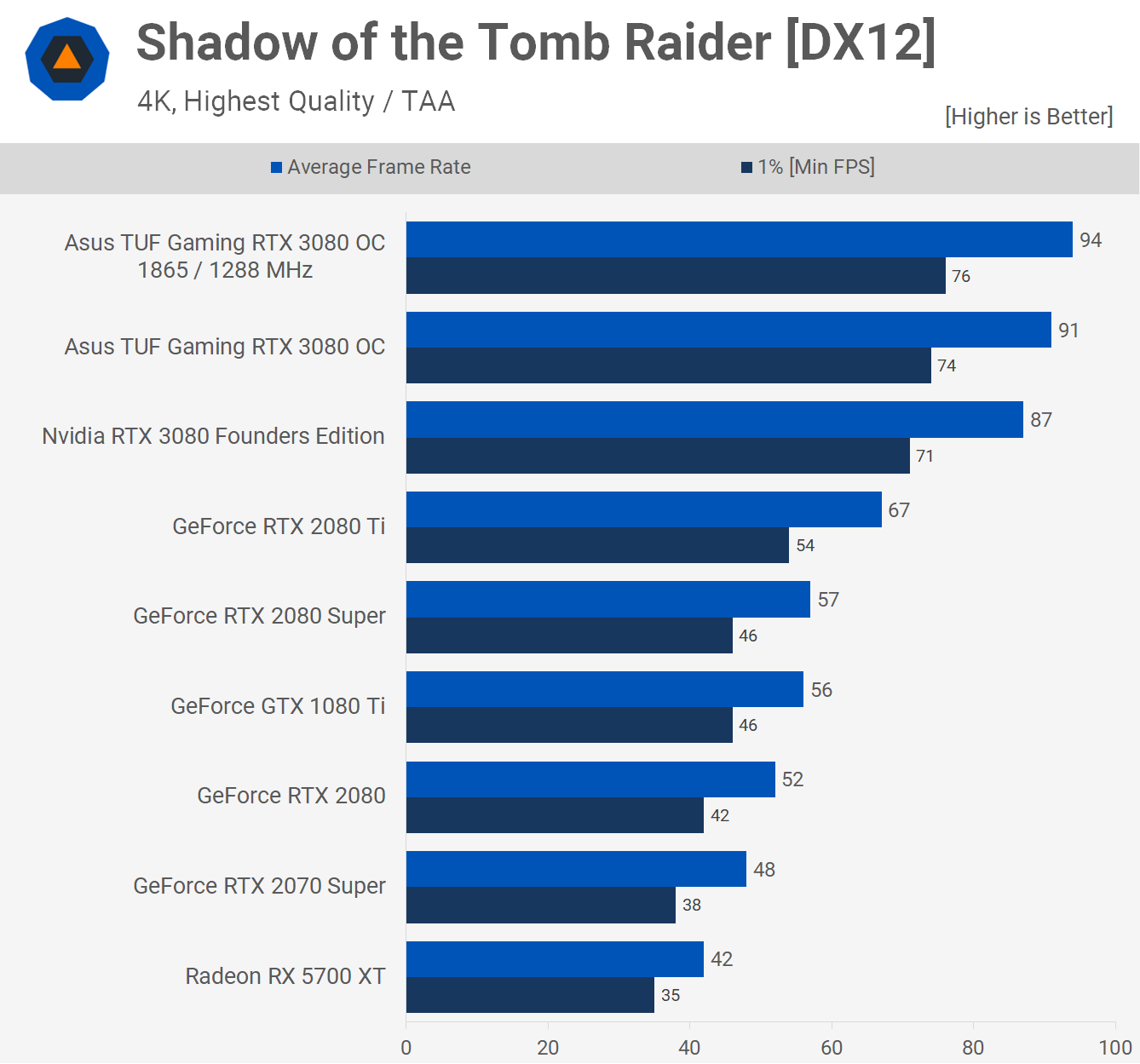
Similar margins were seen at 4K, here the TUF Gaming was 5% faster out of the box and then 8% faster with our overclock, though that was just a 3% increase over the Asus factory overclock.
Temperatures
Here's a more in-depth look at the stock temperatures after running Shadow of the Tomb Raider for 30 minutes in a 21C room. The PCB temperatures were recorded using K-type thermocouples. For the GPU rear PCB temp the probe is attached to the backside of the PCB behind the GPU and we were expecting temperatures to be higher, so it would seem the heatsink on the frontside does a good job of extracting heat from the GPU. The GPU die temperature is the result you've already seen, we're just reporting the internal sensor here.
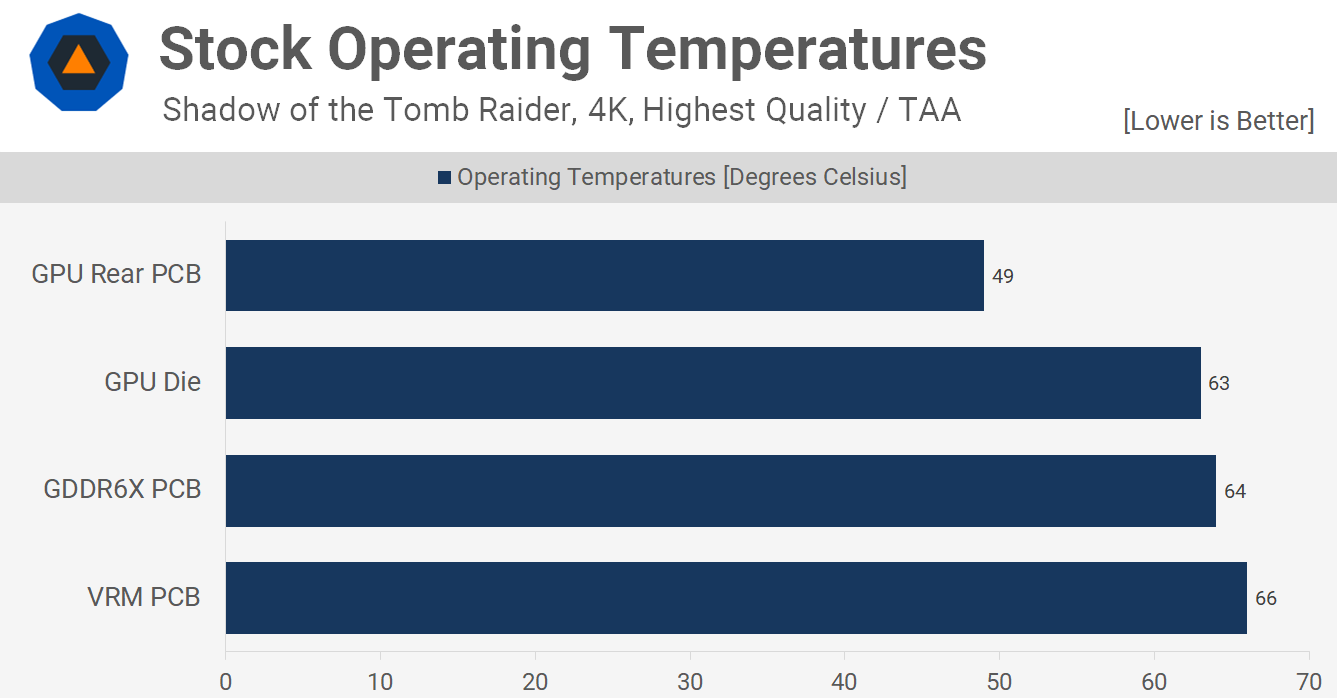
Then the GDDR6X temperature has been reported using a thermal probe, attached to the PCB between the memory chips, so that it doesn't interfere with the thermal pad and it's contact with the memory chip. The same method was used to measure VRM temperatures, 4 probes were used to detect the VRM hot spot and here we're looking at a peak of 66C which is very good. Overall, the TUF Gaming runs surprisingly cool.
What's to Like
Asus has done an excellent job with the TUF Gaming RTX 3080 OC, it's a great quality graphics card and better than Nvidia's own Founders Edition in every measurable way. It's quieter, significantly cooler, faster out of the box and best of all, it doesn't require a silly 12-pin power adapter or specialized cable.
The only area where the Founders Edition model might be better is the physical appearance, but that's entirely subjective. While we do like the look of Nvidia's version, the TUF Gaming still looks great and we appreciate the use of high quality materials all around.
The fact that the TUF Gaming can be up to 6% faster while running 15C cooler seals the deal for us. There's just no way we'd buy the Founders Edition over this Asus model for the same price.
At this point we're still in the process of checking out other AIB RTX 3080 cards, so there might be better options, but we can't imagine they're going to be that much better. We've seen numerous 5700 XT graphics cards that run hotter than the TUF Gaming RTX 3080 OC, so there's no denying Asus has done an excellent job. Should the price be right, then we see no reason not to buy this graphics card.
The Asus TUF Gaming RTX 3080 OC is currently listed for $700, which matches the MSRP for standard RTX 3080 boards. That said, it's also out of stock everywhere we looked, but if you can eventually snag one for $700, then you've done very well.
We were surprised to find how much better this thing is than Nvidia's intricate Founders Edition, and we like to think that our scrutiny with previous TUF Gaming cards helped motivate Asus to put together this excellent design and attention to detail.
